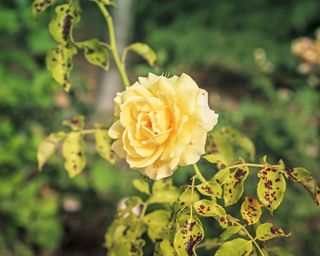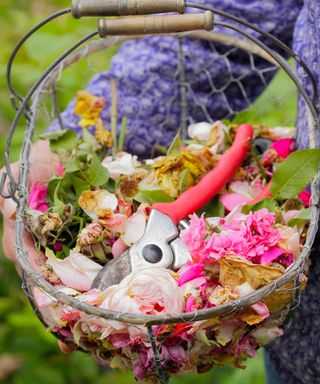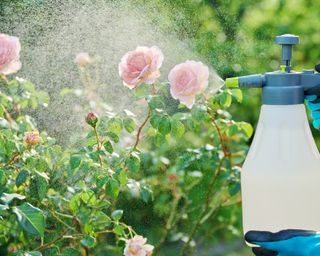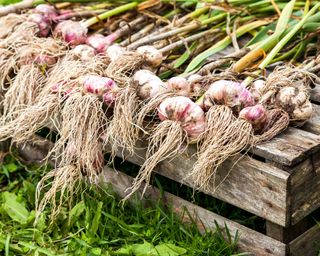Rose lovers love and care for their plants like the most nurturing of parents. So when a disease like black spot strikes, it is a worrying moment that can threaten your plans to start a rose garden.
Black spot on roses is a fungal disease. diplomatic commission. The disease will not kill the plant, but it will damage the beautiful leaves and over time, cause the plant’s health to decline. This is because the leaves begin to die and fall off, slowing down the plant’s sugar production.
The disease appears as irregular, round, black spots with a yellow halo. It is most common when leaves have been wet for too long and still have old plant material on them.
Many gardeners use chemical fungicides to combat disease, but these can accumulate and be toxic, and such formulations can be dangerous to aquatic life. These products also reduce biodiversity and can negatively impact soil health by killing beneficial fungi.
Using homemade, non-toxic products is better for the environment and is often a more cost-effective solution.

(Image source: Getty Images)
Symptoms of black spot disease in roses
Black spot usually starts on the lower leaves of the plant when fungal spores are splashed up during rain or watering. Spots appear three days after infection with new spores forming within 10 days.
Spores develop into round lesions with hairy edges, up to ½ inch (1.3 cm) wide. The spots range in color from black to dark purple, with a lighter center and possibly a yellow border. In addition to leaves, young stems may also have black lesions.
Over time, the leaves turn yellow and fall off the tree. As the tree is deciduous, there is not enough leaf area for photosynthesis and vitality is gradually reduced.
Natural treatment
There are many organic and eco-friendly products on the market, but our homes are full of homemade solutions for managing plants. Most of these solutions are non-toxic and safe to use around children and pets, and do not harm the environment.
1. Good hygiene
The most important thing you can do to control black spot in roses is to practice good plant hygiene.
One of the biggest mistakes when pruning roses is not sterilized pruning tools pruning shears when moving between plants. This can spread the infection to other shrubs.
Always clean up dead plant matter, including leaves, stems and flower heads, from the ground and dispose of them. If left around plants, they will re-infest even treated rose bushes.
Never compost diseased material. Black spot can overwinter in the soil, so preventing it from spreading to other areas should be a top priority.
Prune any canes that show signs of infection with a sharp, sterile tool. Also, thin out shrubs that are too dense, as this will cut off air circulation. For this reason, avoid planting roses too close together.
Do not water overhead, or if the leaves are wet, water only when the leaves have had time to dry. The leaf surface must be continuously moist for seven hours for the disease to develop.

(Image source: Alamy)
2. Neem Oil
Neem oil is a natural product with fungicidal properties. It is not a cure for established black spot infections, but it is a practical and effective management strategy. When used regularly, it helps prevent the germination of fungal spores. It is also effective in treating powdery mildew in roses.
In addition to its use as a fungicide, neem oil is also an extremely effective insecticide, repelling and killing many common insects without causing toxic buildup in the environment.
When roses are infested with pests such as aphids, thrips and spider mites, neem oil will do a double duty in solving multiple problems.
To control black spot and other problems, spray your roses with neem oil every seven days as a foliar spray. Dilute 1-2 tablespoons of neem oil in 1 gallon (3.5 liters) of water and add 1-2 teaspoons of liquid dish soap.
Avoid spraying neem oil solution where beneficial insects such as bees and ladybugs are actively visiting the plant. It is best to spray early in the morning or late in the evening.
3. Sulfur
Sulfur is an old-fashioned solution to many garden problems. It acts as a fungicide by creating an agent that kills fungal spores. It is also a non-toxic insecticide and can be used to lower soil pH if needed.
Sulfur is often sold as a powder or dust to kill fungi. For maximum effectiveness, the product must come into contact with all exposed parts. It is an excellent preventative product with few side effects, although it should be used sparingly.
Formulations with copper are sprayed on the leaves but they wash away in rain or irrigation and must be reapplied frequently.
Copper sulfate can be made into an effective Bordeaux mixture by mixing 1 gallon (3.5 liters) of water with 3 tablespoons (50 ml) of copper sulfate and 10 tablespoons (148 ml) of slaked lime. However, this mixture can cause blue stains on plants, so avoid spraying near surfaces such as wooden fences.
Avoid skin contact with sulfur and copper sulfate as these are toxic to humans – but safe for beneficial insects.

(Image source: Shutterstock)
4. Baking powder
Sodium bicarbonate, or baking soda, is a very inexpensive, easy-to-find treatment that most of us have on hand at home.
Recipe for making black spot spray at home
This spray can be made quickly and easily using household items. Many organic gardeners find it effective against fungal diseases.
– 1 gallon of water
– 1 tablespoon baking soda
– 1 tablespoon white vinegar
– 1 tablespoon vegetable oil
– 1 teaspoon dish soap
Mix well and pour into a spray bottle. Treat roses weekly.
It is effective as a fungicide because it changes the pH of the leaf surface, making it inhospitable to fungal spores. However, too much baking soda on plants can lead to salt buildup, which is harmful to plants, so it should be used sparingly.
Therefore, it is best to use baking soda as a preventative measure or when the dark spot is in its early stages.
Just a spoonful mixed with water makes an effective spray. It can also be mixed with horticultural oil, which will stick to leaves better than water.
5. Growing garlic
Garlic is a natural fungicide and is not favored by many pests, so it is a great companion plant for roses. Onions and chives work similarly.
While planting garlic nearby cannot cure black spot, anecdotal evidence suggests it may reduce the incidence of infection.
Since garlic is not visually objectionable and can be harvested and added to countless recipes, adding garlic to your rose garden is worth a try.

(Image source: Getty Images)
6. Fertilization
Coarse organic mulch has been shown to reduce the presence of black spot spores. Larger pieces keep the area drier, reducing the presence of fungus. For example, cedar mulch tends not to blow away as much as other materials.
Roses are best fertilized in late winter or early spring when they are pruned. Apply a layer about 2-3 inches (5-8cm) thick.
Old-fashioned remedies
The old woman’s stories are still told often in the gardening community. We are a superstitious people and always loyal to the gardening solutions of our ancestors.
Banana peels dug up around rose bushes are said to help kill fungal spores, but there is little evidence that this works. However, the nutrients released as the peels rot will improve the health of the plant.
Milk spray is another solution that has been proposed in the gardening community. The theory is that a 1:1 mixture of milk and water will create another fungus that can combat black spot.
Compost tea can also create beneficial fungal growth on leaves while providing nutrients to plants.
A healthy rose plant is less likely to be affected by black spot disease.
